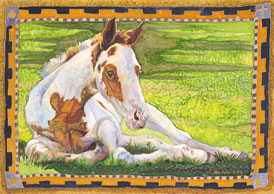|
Showcasing the beauty we all find in the horse
and the passion and creativity that the spirit of the horse inspires
in all who are touched by its presence
“The
Horse in Flathead Valley Collections”
is a fine exhibition of work encompassing images of the horse as it
has evolved through art history. Paintings and sculptures for this exhibit
include works from the Museum’s permanent collection and works loaned
from artists and from private collections around the valley. The exhibit
ranges from historical artists to contemporary, including works by O.C.
Seltzer, Edward Borien, Shorty Shope, E.E. Heikka, as well as local
artists Nancy Dunlop Cawdrey, Betsey Hurd, Eric Kaplan, Karen Young,
and others.
Sponsored by The Wallace Foundation
and Rebecca Farm
|

Where
The Green Grass Grows,
silk painting, 22 1/2 x 32 inches, by Nancy Dunlop Cawdrey
Gallery
Guide with information about the artists included in this exhibition
|
|
For
thousands of years the image of the horse can be found in art
and communications, beginning with the pristine man drawing on the walls
of ancient caves to contemporary artists new west depictions of the
magnificent equine. Romantic depictions of the horse can be found in
images as old as ancient Greece and ancient Egypt.
Through the centuries, equine imagery continued to mature. In
the age of the Renaissance, we found anatomically and proportionally
correct depictions of the horse in the sculptures and drawings by Italian
artists Donatello (1386-1466) and Leonardo da Vinci (1452-1519). Through
art history we continue to see the horse develop in the European movements
of classicism, romanticism, realism and impressionism. But, in America’s
comparatively young art history, we find a new movement
that stems from its European counterpart but is uniquely its own style
- the western American art movement.
For
centuries the horse has had many utilitarian uses but today, one could
argue that its most prized use is that of aesthetic pleasure.
In America, we were caught up with the horse and the many significant
uses. The horse was our trusted companion, our transportation, beast
of burden and vehicle for war. We had draft, race and hunting horses
for sport. Western American artist Fredric Remington (1861-1909) can
be looked at as the Donatello of American artists. His horses possess
both the harmony found in the renaissance masters’ work and the romantic
qualities of notable Spanish artist E. Delacroix (1798-1863). In America,
particularly the west, we have to look at the development of the horse
beginning with the primitive style found in the work of George Catlin
(1796-1872) and Carl Bodmer (1803-1893). Once we have examined their
work, we can move on to the romantic era of the horse in American art
with the works of H. W. Hanson (1854-1924), Edgar Paxson (1852-1919),
Remington and W.R. Leigh (1866-1955) whose horses can be characterized
by exaggerations such as: wide bulging eyes, flaring nostrils and exaggerated
body movements. Aside from Remington’s style, we have the realism of
the west found in the works of Charles M. Russell (1864-1926), Edward
Borein (1872-1945), W. Herbert Dunton (1878-1936) and O.C. Seltzer (1877-1957).
But, when we look at the art of Remington, Russell, Borein and others,
we must observe that we have composition found in the outstanding, and
very difficult to attain, photographs of L.A. Huffman (1854-1931) to
thank. It was through the examination of Huffman’s photographs that
we found many of the wonderful action shots and compositional studies
that Remington, Russell and Borein worked from comfortably.
The
image of the horse that has evolved through art movements that date
back thousands of years and yet it is timeless.
Today, the New West is upon us. In European terms, it derives
its influence from Impressionism and Postimpressionism combined with
American Modernism. We have the bold and exaggerated use of colors,
impressionistic use of space, and the redefinition of reality. But through
it all, the magnificent image of the horse draws us in because of its
familiarity; it is the image of the horse that has evolved through art
movements that date back thousands of years and yet it is timeless.
The image has inspired artists to paint it and collectors to savor it.
For centuries the horse has had many utilitarian uses but today, one
could argue that its most prized use is that of aesthetic pleasure.
|
